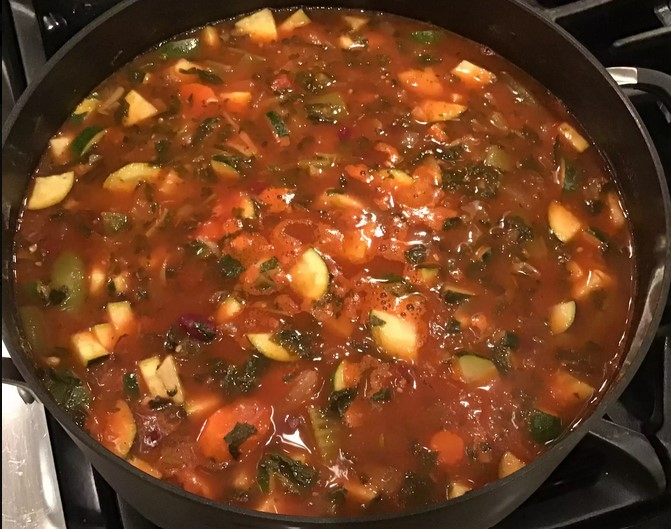
Introduction to Sardinian Cuisine
Sardinian cuisine, a cornerstone of the Mediterranean diet, is celebrated for its vibrant, locally-sourced ingredients and traditional cooking methods. This island’s culinary practices reflect its history, geography, and culture, creating a unique gastronomic experience. Dishes here are not just meals; they are stories told through flavors, with each recipe handed down generations.
What is Sardinian Minestrone Soup?
Sardinian Minestrone Soup is a quintessential dish of the island, showcasing a blend of vegetables, beans, and sometimes pasta or rice. This soup is a beloved staple in Sardinian households, revered for its nutritious properties and versatility. Each family imparts its own variation to the recipe, making it a symbol of heritage and community.
Cultural Significance in Sardinia
In Sardinia, food is a celebration of life and community. The Minestrone Soup, a daily staple, is a testament to this ethos. It’s not just about the ingredients but the love and tradition that go into its preparation. This dish represents the island’s spirit, bringing families together and passing down culinary traditions through generations.
Ingredients and Cooking Techniques
Key Ingredients of Sardinian Minestrone
The Sardinian Minestrone Soup brims with a variety of fresh vegetables, legumes, and grains. Fundamental ingredients include white beans, chickpeas, and fava beans, providing a rich protein base. Vegetables such as tomatoes, carrots, celery, and onions add depth and flavor, while herbs like basil and parsley infuse aromatic nuances. The inclusion of traditional Sardinian pasta or barley brings a hearty texture to the soup.
Local Ingredients and Substitutes
Authentic Sardinian Minestrone uses locally-grown, seasonal vegetables, reflecting the island’s agricultural bounty. However, the recipe is adaptable to regional produce. For those unable to source Sardinian-specific ingredients, common substitutes include cannellini beans for fava beans and standard pasta varieties for Sardinian pasta.
Traditional Cooking Techniques
Traditionally, the soup is prepared with a slow-cooking method, allowing flavors to meld beautifully. Starting with a base of sautéed onions, garlic, and carrots in olive oil, the vegetables and legumes are then gently simmered. This method ensures a rich, layered flavor profile. Explore Italian Cooking Traditions.
Modern Adaptations
Modern adaptations of this recipe often involve time-saving techniques like using canned beans or pressure cooking. These methods cater to contemporary lifestyles while still preserving the essence of the traditional recipe.
Nutritional and Health Benefits
Health Benefits
This delightful soup is not only a culinary treat but also offers numerous health benefits. It is rich in fiber, aiding digestion and promoting a healthy gut. Furthermore, the protein from the beans supports muscle health.
Nutritional Profile
The nutritional profile of Sardinian Minestrone Soup is impressive. It’s low in calories yet filling, making it an ideal choice for those mindful of their calorie intake. The soup is naturally low in fat and cholesterol, beneficial for heart health. Its high fiber content aids in blood sugar regulation, making it suitable for diabetic diets as well.
Preparing and Serving
Step-by-Step Preparation Guide (300 words)
Creating the perfect Sardinian Minestrone Soup involves a blend of simple yet precise steps. Start by soaking the beans overnight to soften them. Sauté onions, garlic, and carrots in olive oil until softened. Add the soaked beans, followed by diced potatoes, chopped celery, and other vegetables. Pour in enough water or vegetable stock to cover the ingredients. Season with herbs like basil and parsley. Simmer the soup on low heat, allowing the flavors to develop over time. The soup should have a thick, stew-like consistency.
Common Mistakes to Avoid (150 words)
One common mistake is rushing the cooking process. Slow simmering is crucial for flavor development. Overcooking the vegetables can make them mushy, so it’s important to add them in stages. Avoid using too much water, as the soup should be hearty and not too liquid.
Serving Suggestions (150 words)
Serve the minestrone warm, garnished with a sprinkle of grated pecorino cheese and a drizzle of extra-virgin olive oil. It pairs beautifully with crusty Sardinian bread and a glass of local red wine. This soup is often served as a main course, given its satisfying and wholesome nature.
Variations and Personal Touches
Regional Variations
Sardinian Minestrone Soup varies across regions, reflecting local tastes and available ingredients. In some areas, the soup includes a specific type of Sardinian pasta, while others might use barley for added texture. Some variations incorporate leafy greens like Swiss chard or kale, providing additional nutrients and flavors. The choice of beans can also vary, with some recipes calling for a mix of fava, cannellini, and red beans.
Adding a Personal Touch
Personalizing the soup is all about experimenting with flavors and ingredients. Home cooks can adjust the types of vegetables based on seasonality and preference. Incorporating fresh herbs like rosemary or thyme can add a unique flavor profile. For a richer soup, consider adding a piece of Parmesan rind during simmering. Those looking for a heartier version might add small cuts of cured meats like pancetta or Sardinian sausage.
FAQs
Regarding common inquiries, many wonder about the distinctiveness of Sardinian Minestrone compared to other variants. Similarly, questions arise about adapting the recipe for vegetarian or vegan diets.
- What makes Sardinian Minestrone different from other minestrone soups? Sardinian Minestrone stands out due to its unique blend of local ingredients and traditional cooking methods. It often includes specific Sardinian vegetables, legumes, and pasta or barley, reflecting the island’s culinary heritage.
- Can I make Sardinian Minestrone Soup vegetarian or vegan? Yes, the soup can easily be adapted for vegetarian or vegan diets by omitting any meat-based ingredients and ensuring that the stock used is plant-based.
- What are the best vegetables to use in Sardinian Minestrone? Traditional vegetables include tomatoes, carrots, celery, and onions. Seasonal greens like Swiss chard can also be added. The key is to use fresh, locally-sourced produce for the best flavor.
- How can I store and reheat leftovers? The soup can be stored in the refrigerator for up to 3-4 days. Reheat on the stove over medium heat, adding a little water if the soup has thickened.
- Is Sardinian Minestrone Soup suitable for a gluten-free diet? It can be made gluten-free by using gluten-free pasta or omitting the pasta entirely. Always check the labels of any store-bought ingredients to ensure they are gluten-free.
Conclusion
In conclusion, the Sardinian Minestrone Soup is a splendid representation of Sardinian culinary traditions, offering both delightful flavors and health benefits. Its versatility and rich history make it a cherished dish worldwide.”
These revisions incorporate more transition words, enhancing the flow and readability of your article. Remember, the goal is to guide the reader through the content smoothly and cohesively.




